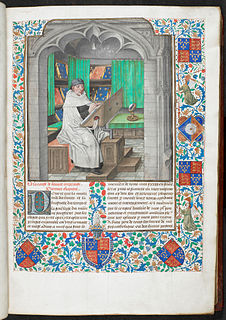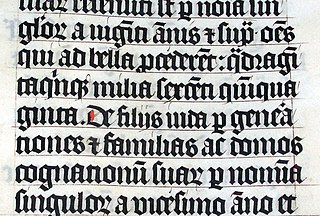
An illuminated manuscript is a manuscript in which the text is supplemented with such decoration as initials, borders (marginalia) and miniature illustrations. In the strictest definition, the term refers only to manuscripts decorated with either gold or silver; but in both common usage and modern scholarship, the term refers to any decorated or illustrated manuscript from Western traditions. Comparable Far Eastern and Mesoamerican works are described as painted. Islamic manuscripts may be referred to as illuminated, illustrated or painted, though using essentially the same techniques as Western works.

The Book of Kells is an illuminated manuscript Gospel book in Latin, containing the four Gospels of the New Testament together with various prefatory texts and tables. It was created in a Columban monastery in either Britain or Ireland and may have had contributions from various Columban institutions from both Britain and Ireland. It is believed to have been created c. 800 AD. The text of the Gospels is largely drawn from the Vulgate, although it also includes several passages drawn from the earlier versions of the Bible known as the Vetus Latina. It is a masterwork of Western calligraphy and represents the pinnacle of Insular illumination. It is also widely regarded as Ireland's finest national treasure.

The Book of Deer is a 10th-century Latin Gospel Book with early 12th-century additions in Latin, Old Irish and Scottish Gaelic. It is noted for containing the earliest surviving Gaelic writing from Scotland.

Giorgio Giulio Clovio or Juraj Julije Klović was an illuminator, miniaturist, and painter born in the Kingdom of Croatia, who was mostly active in Renaissance Italy. He is considered the greatest illuminator of the Italian High Renaissance, and arguably the last very notable artist in the long tradition of the illuminated manuscript, before some modern revivals.

The word miniature, which is derived from the Latin verb miniare is a small illustration used to decorate an ancient or medieval illuminated manuscript; the simple illustrations of the early codices having been miniated or delineated with that pigment. The generally small scale of the medieval pictures has led secondly to an etymological confusion of the term with minuteness and to its application to small paintings, especially portrait miniatures, which did however grow from the same tradition and at least initially used similar techniques.
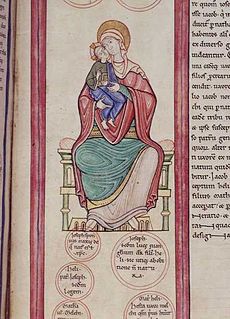
The Parc Abbey Bible is a 12th-century illuminated Bible. It was made in the Leuven region of Belgium at the Abbey of St. Mary of Parc. A colophon on folio 197 indicates that the codex was produced in 1148. The text is Latin and written in proto-gothic book script on vellum. The folios are 437 by 300 mm, with the text block being 340 by 240 mm. The manuscript is illuminated with miniatures, diagrams, decorated borders, and decorated initials. The decorated initials include historiated, inhabited, and foliate initials.
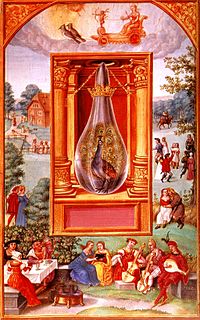
Splendor Solis is a version dated around 1582 of well-known beautifully illuminated alchemical text attributed to Salomon Trismosin.

The acanthus is one of the most common plant forms to make foliage ornament and decoration.

In a written or published work, an initial or drop cap is a letter at the beginning of a word, a chapter, or a paragraph that is larger than the rest of the text. The word is derived from the Latin initialis, which means standing at the beginning. An initial is often several lines in height and in older books or manuscripts, sometimes ornately decorated.
The Arbuthnott Missal is the only extant missal of the Scottish Use. It won a prestigious top award in the British Library's Hidden Treasures competition 2007.

Insular art, also known as Hiberno-Saxon art, is the style of art produced in the post-Roman history of Ireland and Britain. The term derives from insula, the Latin term for "island"; in this period Britain and Ireland shared a largely common style different from that of the rest of Europe. Art historians usually group insular art as part of the Migration Period art movement as well as Early Medieval Western art, and it is the combination of these two traditions that gives the style its special character.
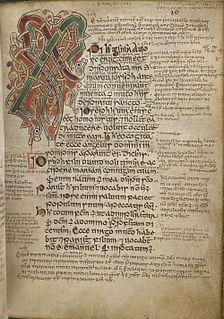
The Gospels of Máel Brigte is an illuminated Gospel Book, with glosses.

Les visions du chevalier Tondal is an illuminated manuscript from 1475, now at the Getty Museum, of a French version of the Visio Tnugdali, of which it is the only fully illuminated manuscript to survive. It has 20 miniatures by Simon Marmion and elaborate borders with "CM" for the initials of Margaret of York, duchess of Burgundy and her husband Charles the Bold. The text was scribed by David Aubert in Ghent, whilst the miniatures were done in Valenciennes, where Marmion was based. Only the pages with the 15 two column miniatures and five single column miniatures have borders, but as there are only 45 folios, the illumination is very full. The manuscript is fully available online.

William de Brailes was an English Early Gothic manuscript illuminator, presumably born in Brailes, Warwickshire. He signed two manuscripts, and apparently worked in Oxford, where he is documented from 1238 to 1252, owning property in Catte Street near the University Church of St Mary the Virgin, roughly on the site now occupied by the chapel of All Souls College, where various members of the book-trade lived. He was married, to Celena, but evidently also held minor orders, as at least three self-portraits show him with a clerical tonsure. This was not unusual: by this date, and with the exception of the St. Albans monk Matthew Paris, the only other English illuminator of the period about whom we have significant personal information, most English illumination seems to have been done in commercial workshops run by laymen.

The Bible of San Paolo fuori le Mura is a 9th-century illuminated Bible. It is the most sumptuous surviving Carolingian Bible.

The Isabella Breviary is a late 15th-century illuminated manuscript housed in the British Library, London. Queen Isabella I was given the manuscript shortly before 1497 by her ambassador Francisco de Rojas to commemorate the double marriage of her children and the children of Emperor Maximilian of Austria and Duchess Mary of Burgundy.

The Howard Psalter and Hours is a 14th-century illuminated prayerbook. It includes a liturgical Psalter with canticles and litany, the Office of the Dead, a calendar of East Anglian origin and an incomplete Hours of the Passion. It was produced between 1310 and 1320. It is written in Latin in a Gothic script in two columns per page. There are 115 extant folios which measure 360 by 235 mm. The text block occupies an area of 250 by 166 mm. It is bound together with the De Lisle Psalter, a contemporary psalter.

The Black Hours of Galeazzo Maria Sforza, M 1856 is an illuminated book of hours, now in the Austrian National Library in Vienna. The book used to be the property of Galeazzo Maria Sforza, the fifth Duke of Milan. It was produced in Bruges, Flanders, probably between 1466 and 1477. Its name derives from its black borders and dark colour scheme, also found in the New York Black Hours, Morgan MS 493, and of a type favoured by the Burgundian court. It is one of about seven surviving black books of hours, all luxury books from the circle of the Burgundian court around this time. It is identified by some with the Black Hours of Charles the Bold that is mentioned in contemporary records, but others disagree.
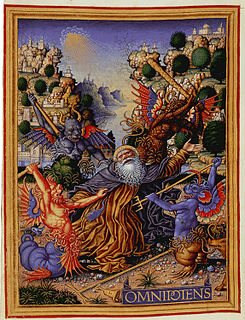
The Sforza Hours, is a richly illuminated book of hours initiated by Bona Sforza, widow of Galeazzo Sforza, Duke of Milan, around 1490, who commissioned the illuminator Giovanni Pietro Birago. The book remained in an unfinished state for 30 years until Margaret of Austria, Regent of the Netherlands, commissioned its completion in 1517–20 from the artist Gerard Horenbout. The book therefore contains decoration of the highest quality by two artists. It provides a unique example of an early sixteenth-century Northern Renaissance illuminator's response to Milanese art of the late Quattrocento. The history of the Sforza Hours also includes one of the earliest recorded examples of art theft.

The Llanbeblig Book of Hours is an illuminated manuscript in the National Library of Wales that dates from the close of the fourteenth century. Entries in the Calendar link the Llanbeblig Hours to Wales and more specifically the dedication of the church of St. Peblig, which is marked June 6th, connects it with Caernarfon.

